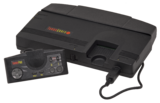Difference between revisions of "PC Engine"
From Sega Retro
Ccawley2011 (talk | contribs) (Removed redirect to nec:PC Engine) Tag: Removed redirect |
Ccawley2011 (talk | contribs) |
||
| Line 22: | Line 22: | ||
}} | }} | ||
}} | }} | ||
| − | <section begin=intro />The ''' | + | <section begin=intro />The '''PC Engine''', released in North America as the '''TurboGrafx-16''' is a video game console originally developed by [[NEC]] and [[Hudson Soft]] in a collaborative effort between 1987 and 1994 (Japan)/1989 and 1995 (US). The system combined a Hudson-produced 8-bit CPU, the HuC6280A (an enhanced 6502 — the TurboGrafx-'''16''' was, in fact, 8-bit — with a six-channel PCM sound system with a few perks) and rather capable video hardware (variable screen resolution, many colors on screen at once and very large sprites, though only two sprite "layers" with a background layer in between). Games were distributed on "HuCards" — effectively a ROM board on a card. There was also a CD add-on which [[CD-ROM²|also saw some Sega releases]]. |
<section end=intro /> | <section end=intro /> | ||
Revision as of 13:18, 30 December 2021

| |||||||||||||
 
| |||||||||||||
| PC Engine | |||||||||||||
|---|---|---|---|---|---|---|---|---|---|---|---|---|---|
| Manufacturer: NEC | |||||||||||||
|
The PC Engine, released in North America as the TurboGrafx-16 is a video game console originally developed by NEC and Hudson Soft in a collaborative effort between 1987 and 1994 (Japan)/1989 and 1995 (US). The system combined a Hudson-produced 8-bit CPU, the HuC6280A (an enhanced 6502 — the TurboGrafx-16 was, in fact, 8-bit — with a six-channel PCM sound system with a few perks) and rather capable video hardware (variable screen resolution, many colors on screen at once and very large sprites, though only two sprite "layers" with a background layer in between). Games were distributed on "HuCards" — effectively a ROM board on a card. There was also a CD add-on which also saw some Sega releases.
Contents
Sega support
While Sega initially supported the platform to some extent, the Sega Mega Drive entered the market in direct competition and so Sega focused their efforts on their own console. In the US, the TurboGrafx-16's marketing was poor (only being sold in major cities and with little advertising), and hence the console landed in a distant third after the Mega Drive and Super Nintendo, but in Japan the tables were turned, with the PC Engine greatly outselling the Mega Drive. This prompted Sega to back the console until the release of the Sega Saturn.
List of Sega games for the PC Engine (JP)
- After Burner II (1987)
- Altered Beast (1988)
- Columns (1990)
- Fantasy Zone (1986)
- OutRun (1986)
- Power Drift (1988)
- Shinobi (1987)
- Space Harrier (1985)
- Thunder Blade (1987)
List of Sega games for the TurboGrafx-16 (US)
- Fantasy Zone (1986)
- Space Harrier (1985)
References
NEC Retro has more information related to PC Engine
|
| Non-Sega consoles |
|---|
| Nintendo |
| Nintendo Entertainment System (1983) | Game Boy (1989) | Super Nintendo Entertainment System (1990) | Nintendo 64 (1996) | Game Boy Color (1998) | Game Boy Advance (2001) | Nintendo GameCube (2001) | Nintendo DS (2004) | Wii (2006) | Nintendo 3DS (2011) | Wii U (2012) | Nintendo Switch (2017) |
| Sony |
| PlayStation (1994) | PlayStation 2 (2000) | PlayStation Portable (2004) | PlayStation 3 (2006) | PlayStation Vita (2011) | PlayStation 4 (2013) | PlayStation 5 (2020) |
| Microsoft |
| Xbox (2001) | Xbox 360 (2005) | Xbox One (2013) | Xbox Series X (2020) |
| Mobile |
| iOS | Android | Windows Phone |
| Other |
| Atari 2600 (1977) | Intellivision (1979) | ColecoVision (1982) | Atari 5200 (1982) | PC Engine (1987) | CD-ROM² (1988) | Super CD-ROM² (1991) | R-Zone (1995) | Game.com (1997) | WonderSwan (1999) | Neo Geo Pocket Color (1999) | N-Gage (2003) | LeapFrog Didj (2008) | Stadia (2019) |
